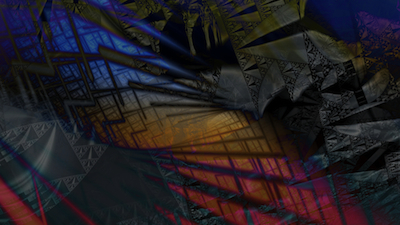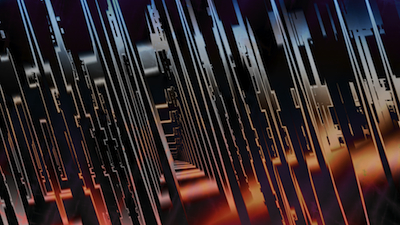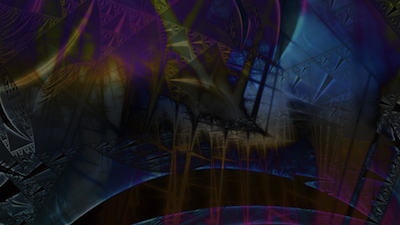 Dear Listener,
Dear Listener,
Every piece of music on this project was directly derived from data generated by the Large Hadron Collider. The LHC is the largest particle accelerator in existence and is arguably the most complex machine ever built. It is an astonishing testament to what we as human beings can do if we work together. Located on the Franco/Swiss border its development, construction and subsequent use has involved the cooperation, both financially as well as technologically, of over one hundred countries. Any physicist in the world may access the data it produces as well as conduct experiments using it either on site or remotely. The super computing grid that was created in order to accommodate the more than six million pieces of data that are collected in any single event, is second to none and is in itself a technological marvel.
The process involved in producing Hadronized Spectra (the LHC sonifications), completed in January of 2013, has been an interesting and protruded one requiring almost two years to accomplish. It began in the spring of 2010 when a friend mentioned that Dr. Lily Asquith, an English physicist working at the LHC, had been interviewed on NPR about a project she was spearheading called LHCSound. I was quite excited about it and, after listening to the interview online, immediately found the web site for her project, which included her contact information, and proceeded to email her. After several informative emails, I was kindly provided access to several sets of data from proton collision events collected using the Atlas Detector at the LHC.
It was clear from the beginning that using the data provided would present an intense challenge. In previous sonification projects I had been dedicated to representing the data in the most accurate form possible, remaining true to its origins, while at the same time producing a very “musical” composition. Otherwise I might just as well use the quasi-random processes I have been working with for years on other projects. The numerical representations of the the photon events were very difficult to work with and yet maintain this attitude and so provided an, at times, overwhelming challenge. Please allow me to explain why by first providing a layman’s description of the process of hadronization as I understand it.
Protons are stripped off hydrogen atoms and are then accelerated to 99.9997% the speed of light by extremely powerful electromagnets. There are two streams each traveling in opposite directions within the ~17 mile long underground tunnel at the LHC. The streams are then crossed within a given detector such as the Atlas, there are several at the LHC, and as the protons collide measurements are taken. (The heat produced by these collisions is many times hotter than the temperature at the core of the sun.) As a result of the collision events “hadrons” are produced, which are basically extremely small sub-particles. Included in the list of sub-particles are several types of gluons, quarks, muons, bosons and etc. Each of those sub-particles split apart into their constituents and so on until there is no more energy to dispel. As the protons come apart in a collision, the angle at which each sub-particle splits off, the energy it releases and other aspects are detected and measured. Here is a list of the data parameters I was provided with and their descriptions using the quantum physicist’s terminology:
Transverse mass: The transverse mass of an event can be thought of in very simple terms as how heavy an event is. Transverse mass is calculated by adding up the mass and transverse momenta of all particles produced in a collision.
Transverse sphericity: The sphericity of an event is a measure of how close the spread of energy in the event is to a sphere in shape. An event which appears to be completely smoothly distributed in three dimensions is spherical and has a sphericity of 1. An event which is clumpy and irregular is closer to having sphericity 0.
Centrality: This is similar to sphericity, but is more a measure of how much of the ‘event’ is contained within the central part of the detector. By the ‘central’ part of the detector we mean the disk (ATLAS is cylindrical) that passes through the collision point.
Electromagnetic fraction: The ATLAS energy detectors are called calorimeters, and there are two types of calorimeter. One of them is designed to measure the energy of particles which interact via the electromagnetic force and the other is designed to measure the energy of particles which interact ‘hadronically’ via the strong nuclear force. The electromagnetic fraction is calculated by dividing the energy detected in the electromagnetic calorimeter by the total energy detected.
Missing energy fraction: ATLAS is designed to be able to detect pretty much any kind of particle. A neutrino, however, is not directly detectable by any part of ATLAS. This funny little particle refuses to interact with anything. Billions of them are passing through your body as you read this, mostly coming from the sun. They will fly right through planet earth without even noticing it is there.  The only way we can detect neutrinos with ATLAS is to look at the spread of detectable energy in the detector and try to balance it according to the laws of conservation of energy and momentum. We calculate the amount of energy carried by the neutrino(s) produced in a collision and subsequent particle decays and divide this by the total detectable energy in an event.
The only way we can detect neutrinos with ATLAS is to look at the spread of detectable energy in the detector and try to balance it according to the laws of conservation of energy and momentum. We calculate the amount of energy carried by the neutrino(s) produced in a collision and subsequent particle decays and divide this by the total detectable energy in an event.
One challenge I had with trying to map the data to a reasonable correlate of my instrument parameters is that the collision events happen so fast that the detectors are unable to capture the timing relationships of the various aspects of the events. Upon discovering this I considered abandoning the project because it seemed there was no way to reasonably represent the events. However, it was decided that these parametric relationships form the basis for cognition within a piece of music. Typically no one can hear or recognize these relationships on a conscious level but it is none the less these relationships that give the listener some, if intangible, connection to the piece. So though the timing would have been nice, it was still possible to work with the data provided.
I proceeded to organize five columns and ten thousand rows of data into the beginnings of a score. This was done in a spreadsheet. Next I had to scale the data into a range usable by the Csound instrument I had designed for the project. This was a sample playback instrument that consisted of 20 parameters, five of which would be provided by the LHC data and 15 would be determined by a stochastic event generator constrained by tendency masks. The output of this instrument was a five channel audio file meant for four speakers and a Low Frequency Emitter (sub). I intended to use the same event data for each of several pieces and soon realized that the scaling of the LHC data, the tendency masks used for the other parameters as well as the choice of base samples selected for each piece would provide an avenue for creative license and yet allow me to remain true to the original data.
For the first piece finished, “Perturbative Expansion”, I allowed myself only minimal editing of the output. I wanted to represent the data in the most raw form possible. For Emergence, though every sound produced came from the LHC data, I gave myself complete permission to edit it in any way I was inspired to. It began as over two hours of sound that was tediously edited down to a fifteen minute piece.
What was interesting throughout the project was, for lack of a better description, the “tonal” quality of much of the sound produced. Many areas within each piece seem to be quite harmonic sounding. This was determined to be an unexpected characteristic of the collision events.
Though it was difficult at first, as I finally began to understand how to work with the LHC data in a way that satisfied all of the criteria set forth,  I found it to be an extremely satisfying and deeply immersive experience. In the end I was quite satisfied with the music it produced.
I found it to be an extremely satisfying and deeply immersive experience. In the end I was quite satisfied with the music it produced.
I hope you enjoy listening to Hadronized Spectra. As with all of my work one should not expect to comprehend it fully at first. Though we live a society that as a rule demands instant gratification… like a very long novel, this project is meant to offer a many layers of many dimensions to explore and in fact might require a lifetime to become completely familiar with. If you are so inclined, allow yourself to delve deeply into the music and consequently into your own perceptions and perhaps consciousness itself as you listen.
Thank you for your attention,
Michael
